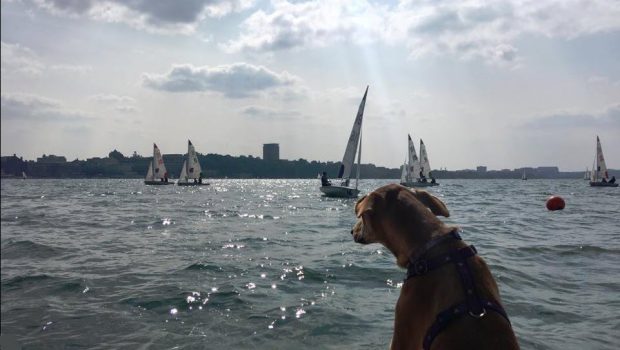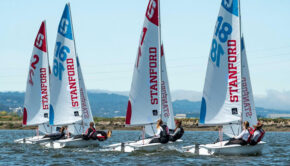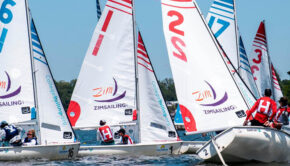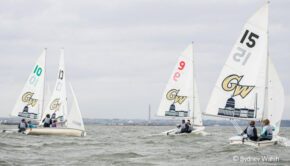College Sailing: Life as a Midwest team
Published on March 6th, 2018
Competition in the Inter-Collegiate Sailing Association is dominated by east coast schools. Scuttlebutt editor Craig Leweck checks in with Dave Elsmo, coach of the sailing team at the University of Wisconsin, on some of the hurdles this top Midwest program faces.
With a full regatta schedule in both the fall and spring, and five National titles scheduled within this span, does the Midwest weather pose some limits?
We are generally fine in the fall but the spring season is a real problem for us. There’s been times when we have gotten to nationals and our lake is still frozen.
For many of the Midwest teams, the challenge is whether their body of water opens up early enough for training and competition. Even a team like Northwestern that sails on Lake Michigan, if it’s blowing out of the northeast or east, they can’t even get their boats in the water because they’re on a beach in an unprotected harbor.
For us, once the lake thaws, it takes us about two weeks to get our piers and assets in order before we can go sailing, so our spring season is definitively shorter. To counter this, we’ll travel to Florida and train at Eckerd during spring break to get some time on the water before our thaw. Once back at school, we get started as soon as we can. For us, it’s, “Are the sheets and sails freezing in between tacks?” That’s not an uncommon situation for some of our early season regattas.
There was a time when teams from all corners of the country were on an even footing at Nationals, but those days are over. Why does your team, which dominates in your conference, struggle at the next level?
Losing local talent is definitely our conference’s biggest issue. Our region has a lot of really great sailors that are coming through the ILYA fleets and the growth of high-school sailing. The problem is the pull of the east coast schools is too great because of the resources they can provide to their athletes.
The top sailing programs are providing their sailors with per diems, with tutoring, and they have athlete status at the university. Here at the University of Wisconsin, we’re not even allowed to call ourselves the “University of Wisconsin Sailing Team.” We can only call ourselves the “Wisconsin Sailing Team” because the university doesn’t recognize sports club teams.
The landscape got severely tilted when school programs initiated more pro-style programming where they have athletic trainers and nutritionists and the full resources of varsity status, particularly when many of these schools don’t have big football programs or big basketball programs so they can do that on a much smaller scale with much more teams.
I get calls or emails all the time from really great sailors asking what I can offer. The best I can offer is to send in a letter of recommendation where as other schools have more pull with admissions. As I see it, it is quite clear that there’s actual recruiting going on even though that’s not allowed at the college sailing level. While financial scholarships are not permitted, there are definitely programs that are making it very beneficial for students to get to their school.
For us, we just don’t have the resources to incentivize good athletes coming to Wisconsin besides the quality of our education system. You’d think that’d be enough, but instead so many go to the higher ranked programs and take the risk of getting lost in their huge rosters. Those schools may have more resources, but they also have a steeper climb to compete at Nationals. If good sailors stuck around the Midwest, they’d be at the top of their teams and then immediately get to nationals. That’s opposed to waiting three or four years.
The spring dinghy nationals has always been the highlight of the school year. Let’s talk about how a format change several years ago impacts your program.
There’s now an extra qualifier regatta at the venue – the semi-finals – that occurs just prior to the women’s and coed nationals. This step has increased the number of teams that can advance from each of the seven conferences to this stage of the nationals, but it has also lengthened the overall nationals event.
For self-funded teams with small rosters, this iteration can be a challenge. It requires more fundraising for the additional days, and for teams that must have sailors competing in all three nationals – women’s, team racing, and coed – it can be a physically taxing grind that can impact their competitiveness.
It’s a lot to take on, particularly for teams less likely to advance from the semifinals. There have been instances when teams that qualified decided not to go. They just couldn’t justify it. The well-funded teams with deeper rosters are not as impacted by this extra stage.
With some of the eastern conferences now so deep, this format seems to benefit those teams that had previously struggled to advance from their conference qualifier.
When the change first came about, I was a student leader on the board of the MCSA, and it felt like it was very clearly a grab by a couple of conferences to make it easier for them to get to nationals. As my perspectives has matured, I see how it as a logical step to insure the college nationals is the most competitive event of the year.
It makes sense for the very best teams to compete for the title. However, based on the teams that have been advancing to the finals since the extra stage was initiated, it has meant that schools from the Midwest, Northwest, Pacific Coast and Southern conferences are now more likely not to be competing in the finals for the title.










 We’ll keep your information safe.
We’ll keep your information safe.